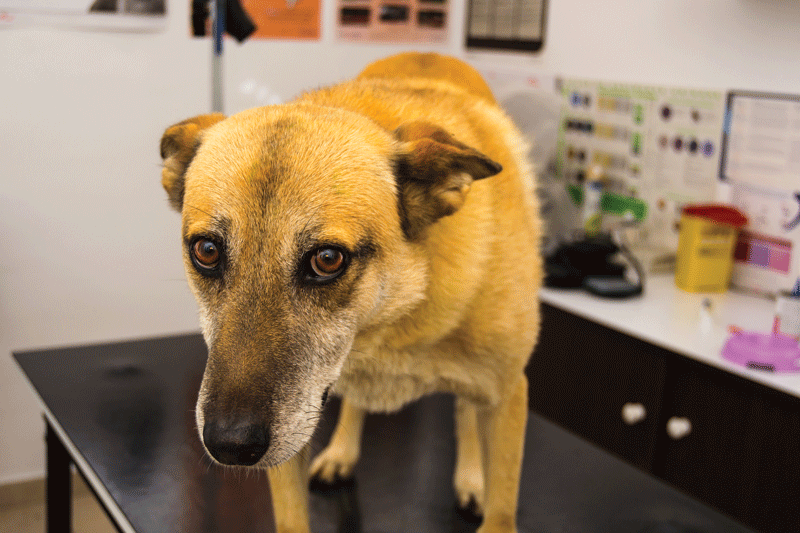
Pet owners are deeply engaged in their pets’ well-being and may become even more sensitive to health needs as pets enter their senior years, hoping to give them the best quality of life for the longest reasonable time. Undoubtedly, discussions around prolonging life quantity, as well, should start early. These conversations allow veterinary teams to use annual or bi-annual wellness visits to discuss preventive care strategies supporting optimal wellness as pets age. Then, when pets reach senior status, veterinary teams are prepared and have set hospital protocols (and client expectations) for how to best keep aging pets healthy. Including diagnostic lab work and parasite screening in wellness protocols is essential to help both veterinarians and pet owners better understand and treat senior pets.
Senior life stage, as defined by the American Animal Hospital Association (AAHA), is the last 25 percent of estimated lifespan for dogs, and greater than 10 years of age for cats.1,2
The 2023 AAHA Senior Care Guidelines support including diagnostic lab work as part of the senior pet’s wellness exams. They recommend a CBC, comprehensive chemistry panel, and urinalysis every six to 12 months, along with annual tick and heartworm screening in dogs, and routine fecal testing in dogs and cats.3
Underscoring the value of diagnostic testing
Some pet owners may initially question the need for laboratory testing during wellness appointments, including ecto- and endoparasite screening. In these situations, it is helpful to communicate assessing patient health necessitates going beyond the pet owner’s subjective reporting of clinical signs and a veterinarian’s physical examination. When we take time to explain the details of what we are assessing with our laboratory tests and review the results in reasonable detail, we create an opportunity to underscore the value of such testing to pet owners.
For instance, we can explain the CBC—spoken as if it is one test—is, instead, a report of 20 to 25 different measurands telling us about the patient’s red blood cells, white blood cells, and platelets. Collectively, the results inform us about possible anemia and the bone marrow’s response, inflammatory disease or immune stimulation, risk of bleeding, and other clinical conditions.
Similarly, the chemistry profile assesses a variety of organ functions, metabolic processes, and endocrine pathways, among others. Importantly, ensuring a urinalysis is included with these blood tests allows veterinarians to interpret changes more accurately in the CBC and chemistry profile, as well as assess both the upper and lower urinary tract.
We have an additional opportunity to reinforce the value in such testing by celebrating “normal” findings when lab work results return with patient values within the reference interval. Rather than just saying, “Everything looks good,” we can reiterate, for instance, that there is no sign of anemia; no indication for inflammatory disease; and liver, kidney, digestive and other metabolic processes appear to be functioning appropriately.
Likewise, endo- and ecto-parasite screening allows the opportunity to “celebrate the negative” when infectious agents are not detected, and we can cheer pet owner compliance with preventatives.
Positive screening tests allow for early intervention and targeted care, may help inform on human risks due to potential zoonosis (e.g. roundworms) or vector-borne disease (e.g. Lyme, Ehrlichia spp.), and prompts veterinary teams to emphasize the need and value of parasite-preventive products.

Establishing appropriate reference intervals
Traditionally, lab work results are reported and evaluated relative to established adult reference intervals. These reference intervals are developed from large cohorts of dogs or cats, representing a variety of breeds, sizes, and ages. As such, these reference intervals are inherently wide and, thus, may be insensitive in detecting abnormalities for an individual animal.
If we have historical lab work results from a particular dog or cat when they are clinically healthy, this provides a much narrower reference interval of health for that individual. This is especially important as our pets age, as individualized reference intervals allow for more sensitive detection of abnormalities, before the individual measured parameters flag high or low (above or below the reference interval, respectively). Earlier detection of abnormalities, before they cross the clinical threshold, allows for earlier intervention with the intent of keeping the patient clinically healthy longer.
Additionally, a laboratory result for an apparently healthy senior patient falling outside the published reference interval may not truly be the result of occult disease but, rather, the reference interval is not appropriate for their age group. Senior/geriatric animals are generally excluded from large studies used to define adult reference intervals; thus, mild abnormalities may need further assessment to determine their clinical relevance in a particular senior pet. Having repeated lab work from annual or bi-annual wellness visits may help “normalize” some mild lab work abnormalities for an individual aging patient, thus helping the clinician focus on any new changes that may be more likely to reflect underlying disease.

Senior pet care is critical all year-round, of course. Consider planning now for in-clinic and social media promotions with photo contests, senior diet samples, etc.
Providing objective evaluation
Defining health can be challenging, especially in our senior pets. Behavioral changes may simply be behavioral (e.g. a dog does not finish its meal because a thunderstorm is approaching, or a cat hides under the bed because there is an unfamiliar visitor) and may not reflect underlying disease. Additionally, when the result of illness, clinical signs are often non-specific and may be difficult to recognize for owners or veterinarians not familiar with an aging pet or may be attributed to a patient’s “old age.” Adult pets with some infections may not show obvious clinical signs, particularly early on, when signs may be subtle or mild. Examples include hookworm infection in adult dogs (typically subclinical, no diarrhea) and heartworm disease (no signs in early stages), both of which would be diagnosed by routine screening as advised by AAHA.
Laboratory diagnostics add particular value in allowing for more objective (and proactive) evaluation of a patient’s health. Then, if abnormalities are detected, more focused and appropriate management may be pursued. As well, senior pets often have comorbidities and lab work results can help clinicians assess the entire patient without becoming myopic and missing important confounding maladies. This is particularly important as we consider pre-anesthetic evaluation of our senior pets prior to dental prophylaxis or surgical procedures, for which awareness of total body health is important to make the safe and appropriate drug and treatment decisions.
As pets age, we focus less on the preventive vaccinations pet parents have come to expect from wellness visits and begin (or hopefully continue) conversations around the value of preventive lab work and ongoing infectious disease screening. Laboratory data from times of health help establish individual patient reference intervals for more sensitive detection of occult disease in our senior patients, some of which may have One Health importance, e.g. hookworms and zoonotic risks.
Additionally, this lab work provides baseline values for more sensitive trending of any abnormalities during disease progression and/or treatment, and it allows more objective assessment of overall health when quality of life is in question and conversations around pain management or end-of-life care may occur.4,5 Just like us, most clients have a very strong bond with their senior pets. When we share the wealth of information that is obtained from laboratory diagnostics, we underscore the importance and value of such testing, which will undoubtedly be welcomed as a means to extend both quantity and quality of a pet’s life.
Holly Brown, DVM, PhD, DACVP is a board-certified clinical pathologist with a passion for maximizing laboratory diagnostics for more informed and improved patient care. Dr. Brown currently serves as chief veterinary educator for Antech Diagnostics and enjoys educating veterinary teams on how to derive the most value from their lab work.
Michelle Evason, BSc, DVM, DACVIM (SAIM), MRCVS serves as global director of Veterinary Clinical Education for Antech (MARS). Dr. Evason has worked in general practice, academia, specialty clinical practice, and in the animal health industry. She has published on numerous infectious diseases, antimicrobial stewardship, nutrition, spectrum of care, veterinary- and pet-owner education related topics.
References
- Creevy K, Grady J, Little S, et al. 2019 AAHA Canine Life Stage Guidelines. Accessed April 2024: https://www.aaha.org/globalassets/02-guidelines/canine-life-stage-2019/2019-aaha-canine-life-stage-guidelines-final.pdf
- Quimby J, Gowland S, Carney H, et al. 2021 AAHA/AAFP Feline Life Stage Guidelines. Accessed April 2024: https://www.aaha.org/globalassets/02-guidelines/feline-life-stage-2021/2021-aaha-aafp-feline-life-stage-guidelines.pdf
- Dhaliwal R, Boynton E, Carrera-Justiz S, et al. 2023 AAHA Senior Care Guidelines for Dogs and Cats. Accessed April 2024: https://www.aaha.org/globalassets/02-guidelines/2023-aaha-senior-care-guidelines-for-dogs-and-cats/resources/2023-aaha-senior-care-guidelines-for-dogs-and-cats.pdf
- Gruen M, Lascelles BD, Colleran E, et al. 2022 AAHA Pain Management Guidelines for Dogs and Cats. Accessed April 2024: https://www.aaha.org/globalassets/02-guidelines/2022-pain-management/resources/2022-aaha-pain-management-guidelines-for-dog-and-cats_updated_060622.pdf
- Bishop G, Cooney K, Cox S, et al. 2016 AAHA/IAAHPC End-of-Life Care Guidelines. Accessed April 2024: https://www.aaha.org/globalassets/02-guidelines/end-of-life-care/2016_aaha_iaahpc_eolc_guidelines.pdf
